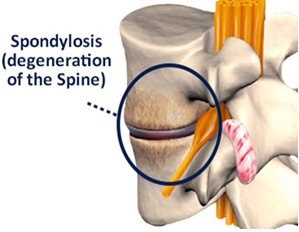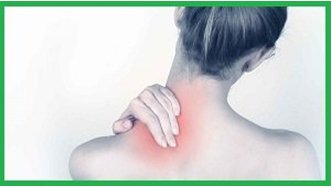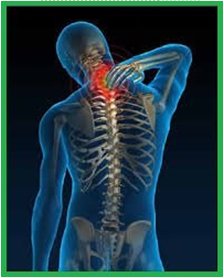
"Spondylosis" refers to degenerative changes in the spine such as bone spurs and degenerating intervertebral discs. Spondylosis is more of a descriptive term than it is a clinical diagnosis. The term Spondylo means the vertebrae and Lysis means disintegration. And in today’s world it has come to embody a general term for age-related wear and tear of the spinal discs.
Degenerative Spondylosis can occur in the cervical spine (neck spondylosis), thoracic spine (upper and mid back), or lumbar spine (low back). Lumbosacral spondylosis is spondylosis that affects both the lumbar spine and the sacral spine (below the lumbar spine, in the midline between the buttocks). While Spondylosis causes majorly is deterioration of the vertebrae, Spondylosis symptoms range wide including pain, numbness and tingling. Multilevel spondylosis means that these changes affect multiple vertebrae in the spine.
Spondylosis Vs Spondylitis:These are two medical terms that sound similar but are different conditions. Spondylitis is inflammation of one or more vertebrae, such as in ankylosing spondylitis, an inflammatory form of arthritis of the spine. This is a very different process than spondylosis because spondylosis is degenerative while spondylitis is inflammatory.
Spinal stenosis, a condition associated with Spondylosis, is a narrowing of the spinal canal that limits the amount of space for the spinal cord and nerves. This puts pressure on the spinal cord and nerves due to limited space, causing pain, numbness, and tingling. Sciatica, also associated with spondylosis, is pain shooting down the sciatic nerve as it runs from the low back down the buttock and the leg, either on one side or both sides. Sciatica often occurs when a herniated disc puts pressure on the sciatic nerve as it exits the spinal canal in the low back.

Low back ache is a challenging clinical condition which necessitates exploring the appropriate underlying cause and the treatment has to be planned accordingly. The main aspect of the treatment is the internal medication paralleled by the therapies judiciously applied at the appropriate clinical condition. Here of course the nature of the therapies whether intensive or mild absolutely relies on the specific case presented. The ache caused by strain, deterioration, improper posture, and those generated by improper food habit shall significantly improve from the treatment. Ayurveda provides complete relief in most cases.

Areas where moderately significant relief can be expected:
These include congenital causes (like Spondylolysthesis), inflammatory causes (like Ankylosing Spondylitis) and Rheumatology disorders. Those with back ache caused by canal stenosis can also find some relief with treatment.Exclusion criteria
Back ache due to visceral, infective (like TB etc.), neoplastic and endocrinal causes may require emergency medical care.Treatment specific information
The treatment for low back ache is wide-ranging: from simple internal medications to intense therapies. The treatment program most appropriate for you will be selected based on the depth of the disease. Among other things, this may include Upanaha (medicinal poultice), pouring of fermented medicated liquid (dhānyāmla), Vasti (medicinal enema) and pouring of medicated oil (dhārā) over the affected part.
"Cervical Spondylosis" is a chronic degenerative condition of the cervical spine that affects the vertebral bodies and intervertebral disks of the neck as well as the contents of the spinal canal. It may also include the degenerative changes in the facet joints, longitudinal ligaments, and ligamentum flavum. Cervical Spondylosis typically presents itself in two ways: you may be experiencing a reduction in functional ability and movements of your arms and hands, or it could be that you have intense, recurring pain (typically in the neck, arms or hands) - or both. Cervical Spondylosis symptoms include the pain areas: in the back, legs, thighs and buttocks that worsens with standing, neck, or shoulder; Muscular: muscle weakness or muscle spasms; and also common symptoms such as low back pain, neck pain, headache, dizziness, sensation of pins and needles, or stiffness
In later stages, spondylotic changes may result in stenosis of the spinal canal, lateral recess, and foramina. Spinal canal stenosis can lead to cervical myelopathy, whereas the latter two may cause radiculopathy. Intervertebral disks lose hydration and elasticity with age, and these losses lead to cracks and fissures. The surrounding ligaments also lose their elastic properties and develop traction spurs. The disk subsequently collapses as a result of biomechanical incompetence, causing the annulus to bulge outward. As the disk space narrows, the annulus bulges, and the facets override.
As disk deterioration and erosion occurs, the uncinate process overrides and hypertrophies, compromising the ventrolateral portion of the foramen. Likewise, facet hypertrophy decreases the dorsolateral aspect of the foramen. This change contributes to the Myelitis and Radiculopathy that is associated with cervical spondylosis.

Cervical Spondylosis is a combination of conditions which requires restoring bone density, as well as removing compression over the nerve, if any. Vaidya.Kortikar, Ayurvedic management is both through internal medication and external therapies, including Panchakarma. The treatment is mainly oriented to ensure regained strength and movements of the arms and hands, as well as pain reduction. In addition to this, Vaidya.Kortikar also focuses on discovering the underlying cause of each patient's condition and providing appropriate corrective measures.
We see particularly strong results with patients who have developed the condition through improper posture and habits. For those who have developed the condition such as cervical spine spondylosis, due to deterioration, health can be restored and maintained, while the progress of deterioration is simultaneously arrested through Ayurveda.
Ayurvedic management is both through internal medication and external therapies, including Panchakarma. The treatment is mainly oriented to ensure regained strength and movements of the arms and hands, as well as pain reduction. In addition to this, Vaidya.Kortikar also focuses on discovering the underlying cause of each patient's condition and providing appropriate corrective measures.